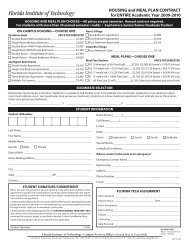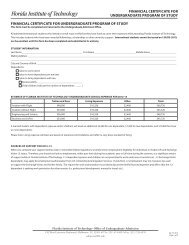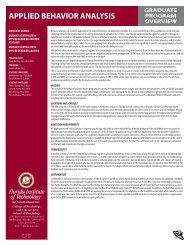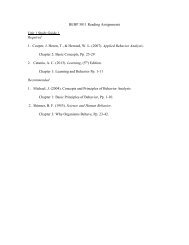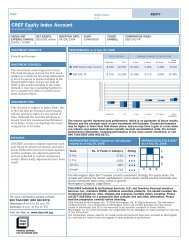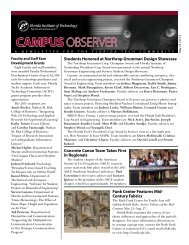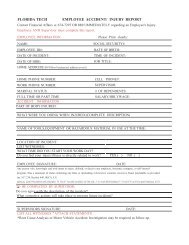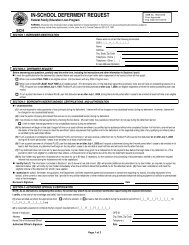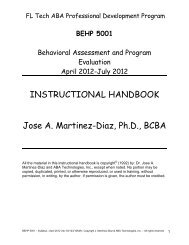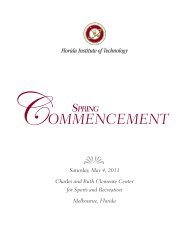Hybrid Course Task Force Proposal 082611.pdf - Florida Institute of ...
Hybrid Course Task Force Proposal 082611.pdf - Florida Institute of ...
Hybrid Course Task Force Proposal 082611.pdf - Florida Institute of ...
You also want an ePaper? Increase the reach of your titles
YUMPU automatically turns print PDFs into web optimized ePapers that Google loves.
<strong>Hybrid</strong> <strong>Course</strong> <strong>Task</strong> <strong>Force</strong><br />
<strong>Hybrid</strong> <strong>Course</strong> <strong>Task</strong> <strong>Force</strong> <strong>Proposal</strong><br />
Mary Bonhomme, Andy Stanfield, Ted Richardson, Richard Newman, Kurt Winkelmann, Matt<br />
Ruane (Resigned, March 11, 2011), Sam Doss, Rick Tankersley, John Windsor, Maria Pozo de<br />
Fernandez<br />
Background<br />
In response to an emerging need on campus for policy and procedures concerning the<br />
development <strong>of</strong> hybrid courses, the Chief Operating Officer Dr. T. Dwayne McCay appointed<br />
the task force to research the topic and make recommendations.<br />
Mission Statement<br />
After the first meeting, the task force drafted a mission statement:<br />
The <strong>Hybrid</strong> <strong>Course</strong> <strong>Task</strong> <strong>Force</strong> is an interdisciplinary group <strong>of</strong> faculty, staff and administrators that will<br />
define hybrid courses, establish standards, and insure quality at <strong>Florida</strong> <strong>Institute</strong> <strong>of</strong> Technology. The<br />
purpose <strong>of</strong> the task force is to enhance educational outcomes, increase the number and variety <strong>of</strong><br />
course <strong>of</strong>ferings, and to establish standards for hybrid courses. The committee will work with both<br />
faculty and administrative staff in order to streamline hybrid implementation across campus.<br />
Literature review<br />
Defining hybrid courses has been problematic for many institutions and organization. Part <strong>of</strong> the<br />
problem has been agreeing upon the exact levels <strong>of</strong> interaction between the face-to-face elements<br />
and the virtual or online elements. For example, the <strong>Florida</strong> Distance Learning Consortium<br />
recommends that hybrid/blended courses be defined as “at least 50 percent and not more than 79<br />
percent <strong>of</strong> the direct instruction [an explicit teaching <strong>of</strong> a skill set using lectures or<br />
demonstrations <strong>of</strong> the material, rather than exploratory models such as inquiry-based learning]<br />
<strong>of</strong> the course is delivered using some form <strong>of</strong> technology when the student and faculty member<br />
are separated by time, space or both” (Recommendations <strong>of</strong> the <strong>Florida</strong> Distance Learning<br />
Consortium, 2009). Other studies such as the collaborative project by the University <strong>of</strong><br />
Wisconsin (UW) System Curricular Redesign Grant Program and several UW campuses tried<br />
different hybrid models, such as reducing class time by 25%-50% or eliminating one class<br />
meeting per week (Garnham & Kaleta, 2002). Some institutions aim for a 50 percent rule with<br />
equal face-to-face and virtual class time.<br />
Furthermore, the U.S. Department <strong>of</strong> Education’s meta-analysis <strong>of</strong> online learning found no<br />
significant differences in learning between fully and partially online students, so adapting quality<br />
assurance criteria for fully-online courses to hybrid courses should not be a problem (U.S.<br />
Department <strong>of</strong> Education, 2010).
In pursuit <strong>of</strong> that mission and based upon current literature and practices, the committee agreed<br />
to the following definitions in order to have the most flexible and largest number <strong>of</strong> choices for<br />
students, faculty, and administrators:<br />
Traditional In-class: These courses have instruction in a face-to-face classroom, with students<br />
and faculty members NOT separated by either time or space. These courses can be webenhanced<br />
through learning materials (handouts, notes, quizzes, etc.) being posted in ANGEL or<br />
the current Learning Management System (LMS).<br />
Blended Learning: These courses have approximately 1/3 <strong>of</strong> the instruction done outside <strong>of</strong> the<br />
traditional classroom.<br />
<strong>Hybrid</strong>: These courses have approximately 2/3 <strong>of</strong> the instruction completed outside <strong>of</strong> a<br />
traditional classroom with online components.<br />
Online: These courses are completely online with no face-to-face meetings (or at most one)<br />
between faculty and students. In these courses, faculty and students are separated by time, space,<br />
or both. Depending on the program or course requirements, some synchronous online sessions<br />
may be required.<br />
All <strong>of</strong> the above definitions assume existing learning objectives will be achieved regardless <strong>of</strong><br />
delivery method and that the focus should be on the learning objectives rather than the amount <strong>of</strong><br />
time spent face-to-face.<br />
Administrative Issues<br />
Process<br />
1. Department/faculty member would identify course’s category.<br />
2. <strong>Course</strong>s are coded within the class schedule so that the students are aware <strong>of</strong> the format<br />
and nature <strong>of</strong> the course. Registrar’s <strong>of</strong>fice should establish a way for codes to be<br />
identified. One <strong>of</strong> the advantages <strong>of</strong> this would be to examine classroom usage and<br />
determine ways to leverage facility usage. For example, potential factors in assigning<br />
classes to rooms might include class size and technology usage. Additionally, this would<br />
maximize the impact <strong>of</strong> the instructional technology equipment inside classrooms,<br />
increasing the university’s return-on-investment in classroom technologies.<br />
Quality Assurance
To assure that courses are properly categorized for students’ ability to choose course formats best<br />
suited to their learning style, we would advocate the use <strong>of</strong> the Quality Matters Peer Review<br />
Rubric.<br />
The task force recommends that the publicly-available Quality Matters Peer Review Rubric<br />
should be used as a guideline for developing a specific rubric for use at <strong>Florida</strong> <strong>Institute</strong> <strong>of</strong><br />
Technology. Either this task force or another committee would need to modify the existing<br />
publicly-available rubric to meet <strong>Florida</strong> Tech’s policies, procedures, and university-specific<br />
definitions concerning hybrid courses.<br />
Requested Actions<br />
Coding System<br />
This committee recommends that the COO establish a new system for the coding <strong>of</strong> the various<br />
types <strong>of</strong> courses that will be available at <strong>Florida</strong> Tech to aid students through the registration<br />
process. For example, a hybrid biology course could be listed as BIO (H) or a similar coding<br />
system that is consistent with current <strong>Florida</strong> Tech computing standards.<br />
Scheduling<br />
To smoothly implement these new course categories, this task force recommends that the COO<br />
appoint a new committee with representatives from Instructional Tech, Registrar, Events<br />
Planning, and a faculty representative from ACITC. This committee would explore how new<br />
course <strong>of</strong>ferings might affect student registration and classroom scheduling and make<br />
recommendations on new policies or procedures that should be established.<br />
Quality Assurance<br />
Just as undergraduate level online courses have to be vetted through the curriculum committee,<br />
hybrid and blended learning courses must also pass through the undergraduate curriculum<br />
committee and the grad council. Additionally, the Engineering ProTrack hybrid courses would<br />
be part <strong>of</strong> Quality Matters rubric and guidelines development process.
Bibliography<br />
Garnham,C. & Kaleta, R. (March 20, 2002) Introduction to <strong>Hybrid</strong> <strong>Course</strong>s. Teaching with<br />
Technology Today. Vol. 8, Number 6.<br />
Notes from the meeting <strong>of</strong> the <strong>Florida</strong> Distance Learning Consortium, 2009.<br />
U.S. Department <strong>of</strong> Education. Evaluation <strong>of</strong> Evidence-Based Practices in Online Learning: A<br />
Meta-Analysis and Review <strong>of</strong> Online Learning Studies, 2010.



